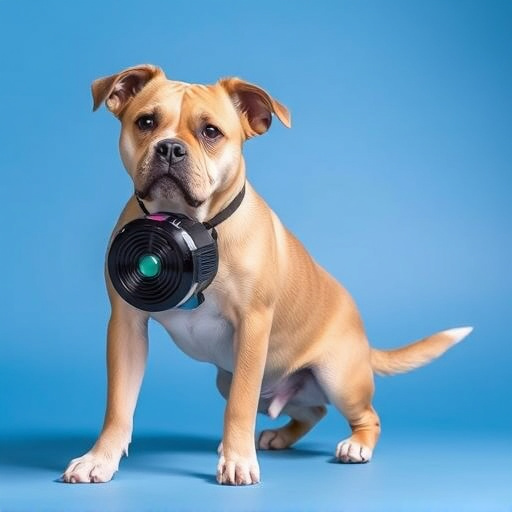Sound wave technology offers a safe and effective solution for pet behavior control outdoors, particularly through dog repellent devices. These devices emit specific sound frequencies to deter unwanted behaviors like barking or digging while promoting calmness in dogs. With extensive outdoor coverage areas, they protect large spaces such as gardens, patios, or neighborhoods. However, their effectiveness and usage should be considered based on factors like range, terrain, and the need for regular maintenance to avoid pets becoming accustomed to the sounds. Ethical concerns also arise, necessitating responsible use and consideration of alternative methods.
Discover the innovative world of sound wave pet behavior control, a non-invasive approach transforming how we manage animal behavior. This article explores cutting-edge technology aimed at calming or deterring pets, focusing on dog repellent devices and their outdoor applications. We delve into the science behind these devices, their effectiveness in various settings, and crucial ethical considerations. Understanding the range of outdoor coverage is key to responsible implementation, ensuring safety and minimizing environmental impact.
- Understanding Sound Wave Technology for Pet Behavior Control
- Dog Repellent Devices: How They Work and Their Effectiveness
- Outdoor Coverage and Range: Considerations for Different Settings
- Ethical Concerns and Safety Tips for Using Sound Wave Pet Behavior Control Devices
Understanding Sound Wave Technology for Pet Behavior Control
Sound wave technology has emerged as a innovative solution for pet behavior control, offering a safe and effective alternative to traditional methods. This technology utilizes specific sound frequencies to influence an animal’s behavior without causing harm. By emitting high-pitched or low-frequency sounds, these devices can deter unwanted behaviors like barking, howling, or digging in dogs, while promoting calmness and reducing anxiety.
For outdoor applications, dog repellent devices that utilize sound wave technology are particularly useful. Their extensive coverage areas allow them to protect large spaces, such as gardens, patios, or even entire neighborhoods. These devices can be easily installed and activated with minimal effort, making them a convenient choice for pet owners looking to manage their pets’ behavior in outdoor settings.
Dog Repellent Devices: How They Work and Their Effectiveness
Dog repellent devices have emerged as innovative solutions for outdoor spaces, offering a humane and effective way to manage canine intrusions. These devices utilize sound waves, often in combination with other sensory stimuli, to create an unpleasant experience for dogs without causing them harm. The technology behind these devices is based on understanding canine behavior and sensitivity to specific frequencies. By emitting high-pitched sounds or ultrasonic waves, which are beyond the human hearing range but irritating to dogs, they effectively deter dogs from entering the treated area.
The effectiveness of dog repellent devices lies in their ability to provide outdoor coverage for various settings, including gardens, patios, and even larger areas like fields and parks. These devices can be mounted on walls, fences, or standalone towers, ensuring a comprehensive protection zone. The range and frequency of sound emissions vary among models, catering to different environments and dog populations. Regular use and proper placement are key to maintaining their efficiency, as dogs can become accustomed to the sounds over time.
Outdoor Coverage and Range: Considerations for Different Settings
In outdoor spaces, the effectiveness of a dog repellent device largely depends on its coverage and range capabilities. For vast areas like gardens or parks, devices with extensive outdoor coverage are essential to ensure comprehensive protection against unwanted canine visitors. These solutions often utilize high-frequency sound waves that are inaudible to humans but disrupt dogs’ communication and navigation, effectively deterring them from entering the treated zones.
Different settings require tailored approaches. In suburban neighborhoods, where properties are closer together, a device with a broader range might be overkill, while rural areas demand devices capable of covering larger distances. Consider the terrain as well; hills or dense vegetation can affect sound wave propagation, necessitating adjustments to the placement and power settings of your chosen dog repellent device for optimal outdoor coverage.
Ethical Concerns and Safety Tips for Using Sound Wave Pet Behavior Control Devices
The use of sound wave pet behavior control devices has sparked ethical debates among animal advocates and researchers. These devices, designed to deter unwanted animal behavior, emit high-frequency sounds that are allegedly unpleasant to animals, particularly dogs. However, concerns arise from the potential for unintended harm or stress to pets, especially when used outdoors where coverage may extend to nearby areas inhabited by other animals, including wildlife.
Safety tips for using these devices include ensuring they comply with relevant safety standards and regulations. Users should also be aware of their specific range and effectiveness, as improper use could lead to false positives or negative impacts on non-target species. Regular maintenance and proper calibration are essential to ensure the device functions correctly and minimizes any potential risks. Additionally, it is crucial to consider alternative methods or concurrent training programs to address pet behavior issues, promoting humane and effective solutions that respect animal welfare.
Sound wave pet behavior control devices offer a non-lethal, humane approach to managing unwanted pet behaviors. By understanding how these technologies work and considering factors like outdoor coverage and ethical implications, pet owners can make informed decisions. While dog repellent devices have shown effectiveness in certain scenarios, individual results may vary. As with any tool, responsible use and safety precautions are paramount. Further research and real-world applications will continue to refine this innovative method of pet behavior control.
